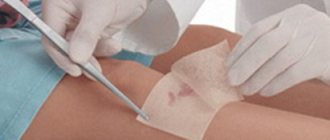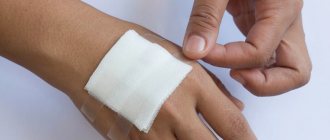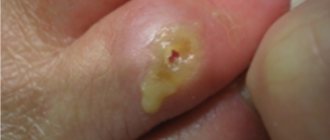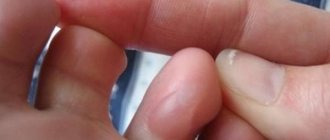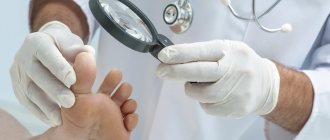The human lymphatic system is actively involved in metabolism, prevents infection from entering the body, and removes harmful substances from cells and tissues. Disturbances and failures of the system in question lead to the formation of edema, ulcers, and damage to the skin. Liquid (ichor), which doctors call lymph, flows out of the diseased area of the body. The pathology cannot be ignored - treatment will not take much time.
Possible reasons
To prevent pathology, it is necessary to find out why lymph leaks. The main factors that cause this problem include:
- blood poisoning – untreated injuries, cuts on the legs and arms lead to infection;
- poor ecology - the quality of the environment also affects the lymph circulation system;
- diseases of blood vessels, skin;
- bad habits: tobacco smoke, nicotine, alcohol negatively affect health;
- difficult working conditions;
- mechanical injuries;
- excessive, exhausting physical activity;
- heart diseases.
Ichor is also released from the damaged area due to surgery. If lymph flows profusely, the wound is oozing, or your legs are swollen, you should immediately seek medical help.
Causes of lymph
Knowing why fluid is flowing from a wound, it is much easier to notice problems in the lymphatic system and consult a doctor. If the flow of lymph is not profuse, there are no other symptoms indicating a complication, then there is nothing to worry about; you should continue normal wound care with the medications prescribed by the doctor. If the wound does not heal for a long time, especially if it is a suture after surgery, you need to visit your doctor and consult with him. Most likely, he will prescribe another treatment using antibiotics.
Excessive fluid flow during injury can occur due to the following complications, pathologies and disorders in the body:
- If a person does not take good care of a complex wound, blood poisoning occurs;
- Poor ecology affects the secretion of lymph;
- Smoking and drinking alcohol negatively affect the functioning of the lymphatic system;
- Dermatological and vascular diseases slow down healing and increase lymph flow;
- Healing does not occur in due time, and more ichor is released if there are heavy loads.
Lymphorrhea and lymphostasis
Lymphedema (lymphostasis) is a disease that appears due to disruptions in the lymphatic system. The ichor gradually collects in the tissues and muscles of the legs, which leads to a change in the appearance of the affected limb. The disease must be treated as early as possible: at an advanced stage there is a risk of becoming disabled, and the leg will eventually lose motor function. Among the causes of lymphostasis are:
- excess body weight;
- breast removal surgery (mastectomy);
- metabolic disorder;
- diseases of the blood vessels of the legs;
- infectious invasions.
Damage to the lymphatic vessels leads to lymphorrhea. The pathology is characterized by copious secretion of ichor: fluid flows from the damaged area and enters the internal organs. Lymphorrhea appears as a result of surgery, trauma, or damage to the extremities.
Symptoms of lymphatic discharge
The ichor that flows from the damaged limb is confused with pus. To determine the release of lymph from a wound, pay attention to the following manifestations:
- legs swell and become covered with ulcers;
- pain at the site of injury;
- deterioration of motor function of joints;
- in the area where lymph is secreted, the skin turns red;
- the patient feels constant fatigue and lethargy.
Pus is distinguished from ichor by the color of the fluid released. Lymph is colorless, but with pus the liquid will be yellow (yellow-green) in color.
Why is clear liquid flowing from the wound?
When body tissues are damaged, the phenomenon of exudation occurs at the site of injury: the vessels increase their capacity and fluid enters the intercellular space. This is how the body tries to get rid of foreign microorganisms. The watery ichor, having fulfilled its role, forms a protective film on the wound.
But sometimes the healing process is disrupted: for example, if there is no initial treatment of a large damaged area, it becomes infected. Then the lymph continues to abundantly irrigate the wound.
Diagnostics
Various diagnostic procedures will help determine the causes of lymph discharge from a wound. Phlebologists recommend the following types of medical examination:
- Ultrasound examination of blood vessels (to prevent thrombosis);
- lymphography;
- lymphoscintography;
- X-ray examination;
- They make a puncture on the injured area of the leg in order to examine the composition of the secreted lymph.
After reviewing the diagnostic results, the doctor will select the correct course of treatment. If lymph is released from the wound due to various diseases, then it is necessary to treat the underlying pathology.
Lymphography
A research method that allows you to accurately identify disorders in the lymph circulation system. The essence of the procedure is the introduction of a special drug (contrast agent) into the human body, which will allow monitoring the outflow of lymph using X-ray images. The method is popular in detecting cancer.
Lymphoscintigraphy
Allows you to examine the general condition of the lymphatic system. Based on the results of the diagnostic method, the neglect of the pathological process is judged. The procedure is performed by injecting radionuclide markers into the subcutaneous layer of the feet. A contrast agent is injected into both legs of the patient, which will allow the composition of the lymph to be compared.
Dopplerography of blood vessels
The method allows you to track the outflow of blood in the venous vessels. Using Doppler sonography, various pathologies associated with narrowing of the lumen of the walls of arteries and veins, and the formation of cholesterol plaques on their walls are revealed. The procedure is performed under the influence of ultrasound, similar to an ultrasound examination.
Dopplerography of blood vessels is an informative and harmless diagnostic method, which is carried out when ichor is isolated from a wound.
Other tests
Magnetic resonance imaging is necessary to detect lymphatic abnormalities. The method allows you to track the outflow of lymph and has no side effects on the human body.
Treatment methods
When lymph is abundantly released from the damaged area, the question of hospitalization arises. If they refuse hospital treatment, they are treated at home, but this must be done under the supervision of an experienced doctor.
During treatment, the patient is prohibited from eating salty and liquid foods.
How to stop the ichor?
If the discharge of lymph is accompanied by severe discomfort, you should treat the wound with hydrogen peroxide using a piece of cotton wool. In case of excessive fluid flow, doctors recommend the following treatment procedures:
- treating the damaged area with a manganese solution;
- dressing the wound with an elastic bandage;
- keep your legs higher than your body while sitting.
For trophic ulcers
The considered pathology of the skin of the lower extremities appears due to varicose veins. Dilation of the veins in the legs is accompanied by the release of lymph and pus with a characteristic unpleasant odor. In such a situation, it is important to prevent germs from entering through the wound.
For treatment, medications are used that are prescribed by the doctor.
Drug therapy
Taking medications for lymph secretion depends on the causes of the pathological process. Cardiomagnyl and Atoris are used for cardiovascular diseases. To effectively relieve swelling, diuretics are prescribed. An effective way to eliminate the problem is to take the drug Phlebodia 600. There are many lubricating medications that will help stop the release of ichor from the wound.
How to stop the flow of lymph?
How to stop lymph on the legs - it depends on the cause of the development of the disorder. Only a doctor should treat affected legs with lymphostasis and lymph secretion, after determining the cause of the pathology.
The first thing you need to do when you notice the discharge of lymph from the extremities is to take a comfortable position so that your legs rest calmly above the level of your heart. To do this, you need to lie down with several large pillows under your feet. Then you should treat the leg with a solution of manganese and bandage the limb. If lymph flows profusely from the wound when the skin is damaged or wounded, despite the measures taken, you should consult a doctor.
Drug therapy
For the treatment of chronic venous and lymphovenous insufficiency in the absence of complications (mild severity), it is recommended to take Phlebodia 1 tablet (600 mg) once a day for 2 months
The release of lymph through the skin can be associated with various diseases. Drug therapy is prescribed by a doctor individually for each patient. For cardiovascular pathologies, diuretics and anti-thrombosis drugs (Cardiomagnyl and analogues) must be prescribed.
For lymphovenous insufficiency, angioprotectors are prescribed - Phlebodia, Diosven, Venosmin, Detralex.
For local application, drugs are used that strengthen the walls of blood vessels, for example, Troxevasin ointment.
For trophic ulcers, antibacterial ointments, vasodilators, and anticoagulants are used externally. Dressings that accelerate tissue regeneration (Branolind, Algipor, etc.) must be used.
Physiotherapy
If lymph oozes from the skin and flows through the skin, physiotherapy can be used. The goal of this treatment is to improve tissue trophism and normalize lymph flow. For this purpose, magnetic therapy, laser therapy, and hydromassage are used.
Magnetic laser therapy is used to accelerate the healing of trophic ulcers.
The number of necessary procedures is determined individually for each patient. On average, at least 10 physical therapy sessions are indicated.
Lymphatic drainage massage
If lymph accumulates under the skin, the lymphatic system must be treated. To improve lymph outflow, lymphatic drainage massage is indicated. It should be performed in a clinic by a qualified massage therapist. After a course of therapeutic massage, the procedure can be continued at home. At home, it is enough to regularly massage the limb from bottom to top with soft rubbing movements to improve lymph flow.
Compression jersey
If clear fluid oozes from the wound, apply a tight bandage. Compression garments help stop the flow of lymph. For lymphostasis, compression class 3 products are prescribed. Such stockings provide the necessary pressure in the lymphatic vessels and veins of the lower extremities and prevent their overstretching.
You can stop the ichor oozing from a small wound using a regular tight bandage. It is important to ensure adequate wound treatment to accelerate tissue recovery.
Diet
If lymphatic drainage is impaired, drinking coffee is contraindicated.
If there are trophic disorders of the lower extremities, you should adhere to a special diet. The diet is based on avoiding foods that retain fluid in tissues. So, you should limit your salt intake. It is allowed to consume no more than 2 g of salt per day during treatment. You should not drink coffee and strong tea, any spicy or salty foods, and fried foods should also be avoided.
Folk remedies
Folk remedies will not help if ichor is secreted from the wound for a long time, but they can be used in addition to drug treatment. To combat swelling and lymph stagnation, traditional medicine suggests using diuretics. You can use an infusion of rosehip, parsley, or a decoction of dandelion leaves.
To treat wounds, you can use a decoction of chamomile or calendula.
Only a doctor can draw up an optimal treatment regimen in each specific case. There is no need to self-medicate and rely on traditional medicine, since the problem can be effectively dealt with only by identifying the cause of its occurrence.
Not all wounds heal quickly: there are often cases when, several days after injury, transparent ichor or lymph . Normally, lymph is involved in cleansing tissues of dirt particles and dead cells. Let's consider in what cases it is necessary to stop its exudation.
Photo 1. If treated incorrectly, lymph turns into pus. Source: Flickr (jmawork)
Physiotherapy
They will improve lymph circulation and restore tone to the leg muscles for many years. The following health procedures are prescribed:
- magnetic therapy;
- hydromassage;
- laser therapy;
- lymphatic drainage
Treatment with decoctions and infusions
Unconventional methods of combating pathology will help stop the release of fluid from the leg due to wounds.
Among the variety of traditional medicine recipes, the following have proven themselves well:
- dandelion infusion - prepared by adding 1 tbsp. crushed flowers in 500 ml of boiling water. The product is infused for 2-3 hours, then drunk before breakfast. Lotions are made from the tincture, applying them to the damaged area;
- compress of honey and garlic - 2 cloves of vegetables and 1 teaspoon. bee product is thoroughly mixed. The resulting remedy is applied to the sore spot using a piece of cloth or a gauze bandage;
- freshly squeezed pomegranate juice - drink every day on an empty stomach until the ichor stops flowing out of the leg.
Medical nutrition
To improve the health of the body, salty dishes are completely excluded from the patient’s menu. Nutrition is based on the consumption of foods rich in animal and plant proteins and amino acids. Sour cream, eggs, milk, lean meat, fish, cottage cheese, fruits, vegetables, beans are the healthiest foods in a situation where lymph flows from a wound.
Is it necessary to stop the flow of lymph from the wound?
The flow of lymph from a wound is a natural protective reaction of the body, so there is no need to stop its release during the inflammation phase (the first stage of wound healing, which lasts up to two days). During this period of time, enzymes and cells of the immune system destroy bacteria and fungi, and also stimulate the formation of new vascular bundles in the wound cavity.
Continued release of ichor 3-5 days after injury indicates the severity of the damage. In this case, it is necessary to stop the flow of lymph so as not to stimulate its degeneration into pus. It is necessary to urgently seek help from a medical institution (surgical department). You will likely need to drain the wound, debride it, and take antibiotics for a while.
Photo 2. If the wound does not heal for too long, antibiotics will be required. Source: Flickr (James Everett)
You should also be alert to the following signs indicating the possibility of suppuration:
- swelling of the wound;
- enlargement of the damaged area;
- the presence of an unpleasant odor from the wound cavity;
- increased pain syndrome;
- temperature increase;
- the appearance of general weakness and lethargy.
It is important! Even minor damage can trigger sepsis (blood poisoning).
Medications
You can use the following pharmaceutical drugs:
- Antiseptics: Hydrogen peroxide 3%, Fukortsin, Chlorhexidine.
- Streptocide dries the wound.
- Medical glue is applied after disinfection.
- Potassium permanganate solution has an antibacterial effect
- The bandage creates compression that stimulates lymph flow.
In the treatment of serious wounds with complications, you may additionally need painkillers (Aspirin, Ketoprofen, Paracetamol or less commonly narcotic analgesics), local anesthetics (Procaine) and antibiotics (cephalosporins).
Folk remedies
Traditional medicine has in its arsenal many remedies for non-healing wounds. If healing is delayed, folk remedies can be used as additional therapy, but they should not completely replace medical treatment.
Cleans the wound well:
- Infusion of plantain leaves.
- Dandelion flower decoction.
- Lotions with a mixture of vodka, honey and propolis.
- Shilajit (crushed form).
- Compresses with grated potatoes.
When clear fluid leaks from a wound for several days, a person may become frightened. Don't panic. Lymph leakage is a common biological process when a cut or open bruise appears.
Compression treatment and kinesiotherapy
Compression garments are worn both to prevent disorders of the lymphatic system and to stop the pathological process. Special knitwear will improve blood circulation and normalize lymph outflow.
Kinesiotherapy is a new physiotherapeutic method that is used to treat various pathologies. To prevent the flow of ichor from the leg, massage and lymphatic drainage are performed. The procedures will relieve swelling and strengthen the walls of blood vessels.
Lymphomassage
Manual and hardware lymphomassage of the lower extremities is useful for improving the functioning of the lymph circulation system. The procedure strengthens the immune system, removes toxins from the body, and improves metabolism. 10-12 massage sessions are enough to prevent discharge from the wound.
Lymphatic drainage massage with abundant lymph flow from the legs is contraindicated for pregnant women and people who suffer from chronic diseases of the skin, kidneys, and liver. The manual type of manipulation is performed independently at home, while the hardware type is done in beauty salons.
One of the most important systems of the human body is the lymphatic system. It is she who acts as a guarantor of protection against various types of infections. If various malfunctions and disturbances occur in it, this leads to the appearance of swelling, ulcers, cracks or other problems on the body. Lesions on the skin may leak a fluid called lymph. Therefore, patients often ask questions: if lymph flows from the leg, what to do in such a situation to stop it? How to prevent repeated violations in the system?
When to see a doctor
If, after surgery or removal of sutures, a profuse flow of clear lymph begins or pus appears, you should immediately consult your doctor. If necessary, the surgeon will clean the wound of purulent leakage and install drainage.
You should consult a specialist if there is a risk of developing suppuration, which is characterized by:
- Severe swelling.
- Unpleasant odor from the wound.
- Redness that “spreads” beyond the damage, from which fluid flows.
- The appearance of pain that increases every day.
- Deterioration of general condition and increase in temperature.
Small cuts and shallow injuries, at first glance, seem to be minor injuries. Improper care can cause blood poisoning. Be vigilant about your health and do not let wound healing take its course.
Lymph is a clear liquid that circulates throughout the body. Its second name is ichor. It performs important functions by cleansing and protecting the body from toxins and infections. The leakage of a small amount of lymph, or ichor, is a normal reaction in deep wounds and damage to the epidermis. At the same time, there are a number of pathologies in which lymph can be released without visible violations of the integrity of the skin. Why lymph flows from the leg and how to stop this process - let's look at it in more detail.
Why is lymph released from wounds?
Initially, it is important to determine why this situation occurs. The main causes of disorders of the body's lymphatic system include:
- blood poisoning, which occurs for various reasons, but most often this is due to the lack of treatment of complex wounds;
- deterioration of the environmental situation surrounding humans;
- the presence of diseases associated with the skin or circulatory system;
- bad habits;
- carrying out work activities in difficult and dangerous conditions, for example, in the chemical industry;
- constant and severe overload of the body, leading to the fact that a clear liquid - lymph - begins to flow from the wounds in the leg;
- suffering complex injuries.
Why does lymph flow from my leg?
Abundant lymph secretion is observed with trophic leg ulcers
The movement of lymph occurs from bottom to top, in the direction from the lower extremities to the collarbones. Lymph washes the entire body, collecting and neutralizing toxins and pathogens. When the integrity of the skin is damaged, blood flows first. After the bleeding has stopped, ichor may be released from the wound for some time - a clear liquid without a specific odor. Moreover, the deeper the wound, the more lymph will come out of it. In this case, the release of lymph from the wound is a completely normal reaction of the body, which is trying to “patch” the damage and prevent the cut from becoming infected.
Normally, after the bleeding stops, a small amount of ichor is released from the wound, and then the regeneration process begins. This indicates that the wound did not become infected.
If clear liquid leaks from the wound for a long time, the cause may be hidden in blood poisoning. This occurs when a wound becomes infected, followed by suppuration, as a result of which pathogenic microorganisms can penetrate the blood.
Ichor may be released from a wound after severe injury or after surgery. If such a symptom persists for a long time (more than several hours), you should consult a doctor.
Abundant lymph secretion is observed with trophic ulcers. This damage to the epidermis is observed with trophic disorders, for example, against the background of varicose veins, erysipelas or diabetes mellitus.
Another reason for the release of ichor is stagnation of lymph in the lower extremities. This condition is called lymphostasis and poses a serious danger.
With lymphostasis and impaired trophism of the lower extremities, pronounced edema develops. In this case, fluid accumulates in the lymphatic vessels. It does not find a way out, so an effusion forms. This effusion seeps into the intercellular space and then exits to the surface of the skin through the pores. Such a disorder can also be observed in various pathologies of the cardiovascular system (coronary heart disease, atrial fibrillation, heart failure, myocardial infarction.)
As a rule, when edema occurs in the lower extremities in older people, doctors first prescribe an ECG. In most cases, grandparents’ legs “leak” precisely because of a disruption in the movement of blood through the systemic circulation. Disruption of lymph flow in this case is a natural complication of pathologies of the cardiovascular system, since lymph stagnation develops against the background of other stagnation in the lower extremities.
Thus, clear fluid may be released from the wound for the following reasons:
- trophic disorders of the tissues of the lower extremities;
- wound infection;
- skin abscess;
- sepsis (blood poisoning);
- ulcers and erysipelas;
- lymphostasis;
- IHD and other cardiovascular pathologies.
Only a doctor can accurately understand the reasons for this phenomenon. There is no need to panic if clear fluid is released from the wound for a few minutes, and then the skin gradually heals without causing discomfort. This phenomenon is absolutely normal and does not require treatment. You should immediately consult a doctor in cases where an effusion forms on the skin without visible damage, the wound does not heal for a long time, or severe swelling of the limbs is observed.
Typical symptoms and complications
Discomfort and pain in the legs when walking are common symptoms of this disease.
Before you understand how to stop leaking lymph, you should understand the symptoms of this phenomenon. Here we are not talking about the natural release of a few drops of ichor during deep cuts, or as a result of accidentally tearing off a healed crust on a wound, but about a pathological condition when lymph discharge from skin pores or wounds is observed on the lower extremities.
Typical symptoms of this condition:
- pronounced swelling of the lower leg and foot;
- discomfort when pressing on the leg;
- fatigue and pain in the legs when walking;
- formation of small wounds;
- severe redness of the skin;
- discharge of clear liquid;
- general malaise, fatigue.
The clear fluid from the wound is lymph. It can be released from trophic ulcers. In this case, the flow of lymph from the ulcer can be very abundant. In severe cases, applying a tight bandage made of several layers of bandage saves literally for 10-15 minutes, after which the dressing material becomes completely wet.
Figuring out when lymph flows from a wound is quite simple. However, with lymphostasis or edema due to severe heart failure, fluid is released through pores in the skin. In this case, constant irritation with ichor causes severe redness of the skin, and over time small ulcers form.
A simple test can be performed to detect swelling of the lower extremities. To do this, press firmly with your finger on the shin and hold for several seconds. Then you should evaluate the depth of the resulting hole and the rate of restoration of skin elasticity. With lymphostasis and impaired tissue trophism, such a hole will be visible on the skin for a long time, while in a healthy person, the skin will restore its previous elasticity in a split second.
The first thing you need to do when you notice water flowing from your leg is to seek help from a doctor. If you let the disease take its course, there is a high probability of severe trophic disorders with damage to leg tissue. Complications of such a disorder can include trophic ulcers, tissue necrosis of the lower limb and gangrene.
Symptoms of the disease
Many people are unable to determine what kind of fluid is flowing from a wound, which raises the question of whether lymph is actually flowing. To make sure that it is the ichor that is being secreted, and not, for example, pus, other symptoms should be taken into account:
- the limb begins to swell, and new ulcers appear that release fluid;
- severe pain occurs in the wound area;
- joint mobility is impaired;
- redness of the skin occurs in places where there are cracks or wounds;
- a person feels constant weakness and heaviness in the area of skin damage.
Treatment begins only after an appropriate diagnosis has been made. However, you can stop the flow of lymph at home immediately after the problem occurs.
How to stop lymph flow from a wound at home
Clear liquid flows from the damaged area, which means the body has activated its protective function. Natural protection in the form of a current of ichor can last up to two days. If there is a constant discharge of clear fluid, 3-5 days after the formation of the wound, additional treatment is required to minimize the risk of pus. This is done through the following steps:
- Cleansing the wound with a drug that has a drying effect.
- Using a topical healing gel or ointment.
- Apply sterile dressings to the injury.
If the wound is constantly oozing, liquid is leaking out, there are unpleasant, uncomfortable sensations, you need to treat the surface with hydrogen peroxide (3%). Soak cotton wool in peroxide and wipe the wound. You can use a solution of brilliant green.
Statistics show that in 15% of cases, suppuration develops after surgical interventions. Doctors recommend treating postoperative sutures with a manganese solution and changing the dressings twice a day.
There are folk recipes for stopping the flow of clear lymphatic fluid and treating non-healing wounds. At home, you can treat with infusions and decoctions of herbs from:
- plantain leaves;
- dandelion flowers;
- mumiyo.
How to stop lymph flow
First, you should consult a doctor so that he examines the patient, listens to his complaints, makes a diagnosis and prescribes treatment. It is important to carry out therapy using a method that eliminates the cause of the disorder in the lymphatic system.
The most common types of treatment are:
- If the appearance of lymphatic discharge is associated with heart disease, then diuretics are prescribed to ensure the outflow of excess fluid, as well as guarantee the normalization of the functioning of the heart and blood vessels.
- If the functioning of blood vessels is disrupted, troxevasin ointment or other drugs of similar action are prescribed, intended to strengthen the walls and improve their elasticity.
- If trophic ulcers or more complex diseases (lymphomas) are detected, surgical treatment is mandatory, since a lymph node with an ulcer or concomitant diseases cause intolerable pain, and it is impossible to eliminate these disorders at home or with conventional medications.
Thus, if you detect lymph flowing from wounds on your leg, you should consult a doctor. A non-healing cut or other damage to the skin is a signal of a significant disorder in the body.
Description of lymph (ichor)
At the moment, the lymphatic system is one of the least studied structures of the human body. It is believed that it is just an application to the cardiovascular system. The functions of lymph are to nourish body tissues, filtering out waste products, and transport lymphocytes .
Its structure includes vessels, nodes and organs (spleen, thymus gland behind the sternum and tonsils).
The lymphatic system performs its functions through the flow of lymph - a fluid that circulates freely in the body and, if necessary, enters the intercellular space. Its content in the body is approximately 1-3 liters. Lymph moves from bottom to top at a speed of 5-16 cm/min.
It consists of two fractions: lymphoplasm and formed elements (lymphocytes, leukocytes). The plasma component includes proteins, electrolytes, enzymes, fats and sugars.
Lymph is usually a transparent substance, but milky white and yellowish colors are within normal limits.
How to distinguish pus from lymph
The formation of pus is associated with insufficient cleansing of the wound: dead protective cells (lymphocytes, neutrophils, macrophages, etc.) in the released ichor become a breeding ground for pathogenic microorganisms that inseminate the wound.
Note! Purulent inflammation indicates that the immune and lymphatic systems cannot cope with the resulting load. Therefore, to avoid complications, antibiotics are prescribed for suppuration.
| Lymph | Pus | |
| At what phase of healing does it occur? | Inflammatory phase | Inflammatory phase |
| Color | Characterized by transparency; color ranges from white (cream) to yellow | Cloudy exudate of dirty yellow, green, gray, blue color (depending on the microbial composition) |
| Smell | Absent | At the beginning there is no selection; over time - unpleasant putrid |
| Consistency | Watery, slightly viscous | Newly formed pus is liquid; gets thicker over time |
| Presence of blood clots and vessels | Maybe | Maybe |
How to stop lymph flow yourself
If the wound becomes wet and a small amount of lymph flows out of it, then you can cope with this problem at home. The following procedures are used for this:
- A manganese solution and bandage are prepared, and you can also use medical alcohol or a tincture based on calendula. But it is undesirable to use them in their pure form, so water is prepared and mixed with the solution in optimal proportions.
- If lymph is secreted due to swelling, then the bandage is moistened in the prepared solution, after which it is used to bandage the damaged area on the leg. The bandage should not be removed until completely dry. After the wound has dried, it is replaced with a new one. The process is repeated until the ulcer is completely healed.
- If there is a need to relieve swelling from the legs, then it is advisable to initially use not an ordinary bandage, but an elastic one.
- While in a sitting or lying position, it is advisable to take a position in which the legs are located higher than the body; you can use various bolsters.
- During the period of lymph secretion, heavy loads on the legs are not allowed, you cannot lift heavy objects or walk for a long time.
If lymph leakage is detected from the wound, you must visit a specialist. There can be many reasons for this pathology. You can use some tips to stop the flow of ichor at home after consulting with your doctor.
What determines the amount of fluid filling a pimple?
It is important to know the reason for the appearance of clear liquid at the root of the problem.
- Your skin should be exfoliated regularly to get rid of oil, dead skin and cells so that it can look fresh and new. Clogged skin pores most often result in a buildup of dead skin cells and bodies coming out of the skin as a clear fluid from the pimple.
- Hormonal changes are the underlying cause of most pimples. Increasing testosterone levels and fluctuations in estrogen levels (in the case of women) pave the way for the accumulation of pimples in different areas of the body and face.
- Pollution With environmental degradation, it is really difficult to avoid the effects of environmental degradation on your skin. Pollutants affect it and have a detrimental effect on the clearness of the skin, resulting in pimples and breakouts on the face.
What determines the amount of fluid filling a pimple?
It is important to know the reason for the appearance of clear liquid at the root of the problem.
- Your skin should be exfoliated regularly to get rid of oil, dead skin and cells so that it can look fresh and new. Clogged skin pores most often result in a buildup of dead skin cells and bodies coming out of the skin as a clear fluid from the pimple.
- Hormonal changes are the underlying cause of most pimples. Increasing testosterone levels and fluctuations in estrogen levels (in the case of women) pave the way for the accumulation of pimples in different areas of the body and face.
- Pollution With environmental degradation, it is really difficult to avoid the effects of environmental degradation on your skin. Pollutants affect it and have a detrimental effect on the clearness of the skin, resulting in pimples and breakouts on the face.
Although the most common causes of breakouts and pimples on the face have been written above, there may also be other reasons such as unhealthy diet, oily skin, lack of personal hygiene, etc.
What is that clear liquid coming out of a pimple?
Transparent fluid from a pimple most often flows out of a pimple by squeezing it or touching a very swollen pimple. Such actions on your part are completely unreasonable, since squeezing and leaking fluid from a pimple also provokes the appearance of pimples in neighboring areas of the skin, and, according to medical observations , on average, 1 squeezed pimple can cause 2 more. In addition, according to the opinion of most dermatologists, a pimple after squeezing significantly slows down the process of its maturation, also leaving behind scars, blemishes or scars.
According to most people, the white fluid that comes out of a pimple is pus, and the clear fluid that comes out of it is pus. In some cases this is true, but not always. There are other types of white fluid that you may mistake for pus. Let's take a closer look at them.
Well, in many cases, the white liquid in pimples can be pus and it can be contagious. These pimples are also known as pustules and should be treated with utmost care. If touched, the pus can spread to nearby areas of skin and hence spread the infection further more.
Getting it on nearby areas will not only increase the chances of spreading pus and infection, but will also leave a permanent pimple on your skin. Hence, we strongly advise you not to pop your pimples.

